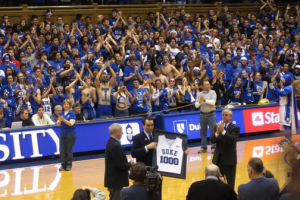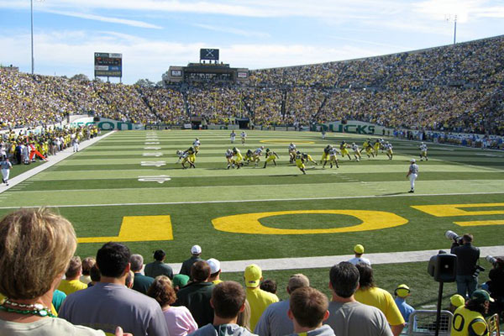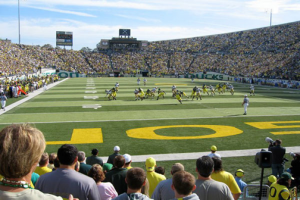On October 8, 1988, an earthquake registered on the Louisiana State University seismograph. This earthquake was unique. Buildings did not topple, and for the most part, no injuries were sustained. Except for maybe an Auburn fan.
The LSU Tigers were down 6-0 to the Auburn Tigers with less than two minutes left in the fourth quarter when, on fourth down, quarterback Tommy Hodson connected with Eddie Fuller in the endzone, putting LSU on top for good, 7-6. The ensuing eruption from the stands was registered on the university’s seismograph as an earthquake over 15-20 minutes. The Viking looked at some of the outrageous high school and college sports environments.
HIGH SCHOOL SPORTS VENUES
SLOWEST: Saratoga’s Pool
“The walls are really slippery. When you turn, you slip and your push off the wall isnt as strong and you don’t get as much acceleration and your time isn’t as good,” varsity swimmer Maddie Berger (‘12) said.
Swimmers expressed many different aspects that make a pool fast, such as the construction of the gutters. They attribute the difference to the presence of overflow gutters. If the pool only has a wall, the water bounces back, which especially affects the swimmer in the outside lane, who is the first to experience the push back of waves into their lane. The temperature and pH balances of pools also have an impact on speed; a hot pool takes away energy from the swimmer due to the heat, whereas a cold pool is harder to swim through and takes more energy to move. Walls can also have an effect on swimming times. Slippery walls do not allow swimmers to push off the wall as hard, which can slow them down.
MOST UNPREDICTABLE: Leland’s Field
“Some of the older grass fields like Leland’s are pretty bad because the random patches of dirt make the direction of the ball unpredictable,” varsity lacrosse player Kimmie Flather (’12) said.
A key to success in lacrosse is being able to gracefully pick up ground balls while on the move. This is nearly impossible at Leland High School’s grass lacrosse field, due to chunks of ripped out grass, puddles, and potholes. Sticks get stuck in the grass when going for ground balls, and athletes slip, twist their ankles or straight out fall.
MOST DISTRACTING: Gunn’s Basketball Court
“The baskets are just floating and have no background to give you depth perception.” varsity basketball player Charlie Jones (‘11) said.
Shooting requires the ability judge the relative distance between the basket and the shooter, but in Gunn’s case, the disproportionate court does not help. The bleachers extend nearly right against the sidelines, which creates a squished-in feeling. The floating baskets make the baseline seem farther away from the court, thus creating a feeling of a longer, yet narrow court.
COLLEGE SPORTS VENUES
HARDEST TO CONCENTRATE: Autzen Stadium (University of Oregon)
Home to the 2011 BCS runner-up Oregon Ducks football team, Autzen Stadium holds 54,000, but has exceeded that number every game since their last expansion in 2002. Bleachers reach less than 10 feet from the field, which augments the crowd noise. Former University of California, Berkeley and current Detroit Lions running back Jahvid Best told the San Francisco Chronicle, “The biggest thing I remember about that game is the crowd. The crowd noise is crazy up there. Honestly, any other away game I don’t really even hear the crowd. Oregon was the only place where it really got on my nerves.”
MOST COLORFUL: Bronco Stadium (Boise State University)
Two words: blue grass. Bronco Stadium was the first, and is the only field in FBS with non-green grass. Earlier this year, Oregon State painted their practice field blue in preparation of their upcoming game against Boise State. (It did not work. They lost, 37-24.) The Broncos also wear blue jerseys, which, for an opposing team, can mesh with the field. “I think it is an advantage for sure,” Oregon State head coach Mike Riley told ESPN. “Even watching them on film, it’s hard to get numbers. It all blends together.” Obviously, this tactic has worked for them, as they have compiled a 62 game home winning streak. Bronco Stadium also currently hosts the Humanitarian Bowl.
CRAZIEST: Cameron Indoor Stadium (Duke University)

Cameron Indoor Stadium was built in 1940 by the same architectural firm who built the Palestra for the University of Pennsylvania. The infamous “Cameron Crazies” of Duke, known for their outrageous and raucous personal jeers, are the only fans allowed to cheer on the Blue Devils court side. With the small size of the stadium (it only seats 9,314 people), the attacks are only amplified. Fans consistently stand up in Cameron Indoor Stadium, exceeding its capacity. The Blue Devils have a .873 winning percentage at Coach K Court under current head men’s basketball coach, Mike Krzyzewski, whom the court is named after. Sports Illustrated named it fourth on a list of the top 20 sporting venues in the world in the 20th Century.




